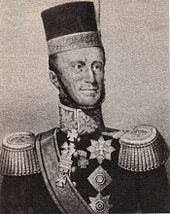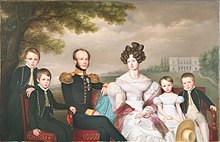Wilhelm II (Netherlands)
Wilhelm Friedrich Georg Ludwig von Oranien-Nassau ( Dutch Willem Frederik George Lodewijk van Oranje-Nassau ; * December 6, 1792 in The Hague ; † March 17, 1849 in Tilburg ) was Wilhelm II, the second King of the Netherlands and Grand Duke in personal union from Luxembourg . He ruled from October 7, 1840 until his death in 1849.
Life
Wilhelm II. Was the son of Prince Friedrich Wilhelm of Orange-Nassau, the future King 1792 William I , was born. He was educated in the military academy in Berlin , then studied at Oxford and entered the English military service . During the war in the Iberian Peninsula, he was adjutant to the Duke of Wellington . As Crown Prince of the Netherlands, he commanded the Dutch army in 1815 and fought at Quatre-Bras and Waterloo , where he was slightly wounded in the late afternoon of June 18 at the site of today's Lion's Mound . Wellington later said of him: "The prince is a brave young man, that's all ..." His troops called him - a little condescendingly - the "slim Billy".
In 1830, when the Belgian Revolution broke out , the prince immediately went to Belgium , where he, overstepping his authority, recognized the freedom of Belgium on October 16. The king took the prince's concession, and the prince then went to England. In 1831 he again took command of the Dutch army, which he led victoriously in the war with Belgium in August until he had to withdraw from the armed intervention of France. Later he was in command of the Dutch observation army on the Belgian border.
After his father's abdication on October 7, 1840, he became head of government. He approached his office energetically. He tried to counter the growing financial hardship with decisive means. However, he refused to introduce the required political reforms until, under the threat of the European revolutions in 1848, after negotiations with Prime Minister Johan Rudolf Thorbecke, he consented to the introduction of the constitution and thus the parliamentary monarchy that still exists today. It was said at the time that Wilhelm had changed from conservative to liberal in one day. From him the statement has been handed down: “You have to march with your century, you have to walk freely on the constitutional path. There is no other way for the sovereigns. ”After his death (1849) he was followed by his son Wilhelm III .
Wilhelm II had a preference for the city of Tilburg ( Noord-Brabant ), where he had a palace built in 1847. The football club Willem II Tilburg was named after him . He was buried on April 4, 1849 in Delft in the Nieuwe Kerk , the family crypt of the Royal Family of the Netherlands.
progeny
Wilhelm married the Grand Duchess Anna Pawlowna (1795–1865), daughter of the Russian Tsar Paul I and the German Princess Sophie Dorothee von Württemberg on February 21, 1816 in Saint Petersburg . This marriage produced five children, four sons and one daughter:
- William III. Alexander Paul Friedrich Ludwig (1817–1890)
- Wilhelm Alexander Friedrich Konstantin Nikolaus Michael (1818–1848)
- Wilhelm Friedrich Heinrich (1820–1879)
- Wilhelm Alexander Ernst Casimir Friedrich (1822–1822)
- Wilhelmine Marie Sophie Luise (1824-1897); ⚭ 1842 Karl Alexander of Saxe-Weimar-Eisenach (1818–1901)
title
Wilhelm II was Prince of Orange-Nassau, Prince of Orange , Prince of the Netherlands (until 1840), from 1840 King of the Netherlands, Grand Duke of Luxembourg and Duke of Limburg .
literature
- Jan G. Kikkert: De drie Oranje Koningen. Willem I, Willem II, Willem III. 2nd pressure. Aspect, Soesterberg 2010, ISBN 978-90-5911-910-9 .
- Jeroen van Zanten: Koning Willem II. 1792-1849 . Boom, Amsterdam 2013, ISBN 978-90-8953-303-6 .
ancestors
| William IV of Orange (1711–1751) | |||||||||||||
| William V of Orange (1748–1806) | |||||||||||||
| Anna of Great Britain, Ireland and Hanover (1709–1759) | |||||||||||||
| Wilhelm I , King of the Netherlands (1772–1843) | |||||||||||||
| August Wilhelm of Prussia (1722–1758) | |||||||||||||
| Wilhelmine of Prussia (1751-1820) | |||||||||||||
| Luise of Braunschweig-Wolfenbüttel (1722–1780) | |||||||||||||
| Wilhelm II. King of the Netherlands | |||||||||||||
| August Wilhelm of Prussia (1722–1758) | |||||||||||||
| Friedrich Wilhelm II. King of Prussia (1744–1797) | |||||||||||||
| Luise of Braunschweig-Wolfenbüttel (1722–1780) | |||||||||||||
| Wilhelmine of Prussia (1774–1837) | |||||||||||||
| Louis IX of Hessen-Darmstadt (1719–1790) | |||||||||||||
| Friederike Luise of Hessen-Darmstadt (1751–1805) | |||||||||||||
| Caroline of Pfalz-Zweibrücken (1721–1774) | |||||||||||||
Footnotes
- ↑ Horst Lademacher : History of the Netherlands . Scientific Book Society, Darmstadt 1983. p. 226.
- ^ Ernst Heinrich Kossmann: De Lage Landen 1780–1940. Anderhalve eeuw Nederland en België . Elsevier, Amsterdam 1976, ISBN 90-10-01513-0 , p. 126.
- ↑ Horst Lademacher: History of the Netherlands . Scientific Book Society, Darmstadt 1983. p. 277.
Web links
| predecessor | Office | successor |
|---|---|---|
| Wilhelm I. |
King of the Netherlands Grand Duke of Luxembourg 1840–1849 |
William III. |
| personal data | |
|---|---|
| SURNAME | Wilhelm II. |
| ALTERNATIVE NAMES | Wilhelm Friedrich Georg Ludwig of Orange-Nassau |
| BRIEF DESCRIPTION | King of the Netherlands |
| DATE OF BIRTH | December 6, 1792 |
| PLACE OF BIRTH | The hague |
| DATE OF DEATH | March 17, 1849 |
| Place of death | Tilburg |




